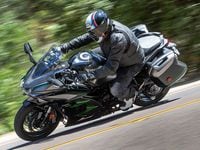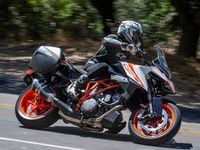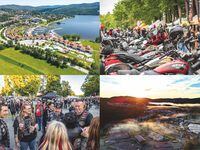We began this series with a look at the consistently quick lap times of a roadracing champion, exemplified by Jorge Lorenzo. In Part 2 Alex Hatfield discussed consistency with a weapon, whether it was on two wheels or mounted below a scope. In Part 3 we focused on how top riders like Chris Peris find consistency by immediately and constantly adjusting brake pressure into corners, illustrated by Yamaha’s Y-TRAC data acquisition system.
From each of these three articles we can pull lessons to improve our on-bike consistency, but it would be easy to think consistency pertains mainly to track riders. Street riding lacks the measurability of lap times and finishing positions. Or does it?
Do we arrive at our destination? How steady is our heart rate during the ride? How often are we coasting, out of control? How many times are we surprised? How often are we off our desired line? How many close calls do we have? How many times do we fail to foresee a problem? How many times do our tires break traction? How many times do we fail to smoothly operate the controls? What is our comfort level? How many times does pure luck allow us to survive a potential incident?
All of those questions help street riders measure how we are doing and each forms a basis for its own article, but this week’s view on consistency will be aimed at where street riders are dying most frequently: Running wide in corners. On backroads that means over the centerline or into the right verge, in intersections it means hitting curbs and poles and signs, while navigating on-ramps and off-ramps it means hitting guardrails or running into the verge.
This column has been tightly focused on the skills of trail-braking, initial throttle, visual habits, body position…all the skills we need to navigate corners on the street or track, but this week’s mental outlook rivals all those skills. This week we step back from what our bodies are doing on the bike to how our minds should think about corner entry: It serves to get our bike ready to exit.
A corner can be simplified into three sections: Entry, middle, and exit. On entry we are generally slowing with deceleration or deceleration plus braking as we add lean angle and tighten our radius. In the middle of the corner we are transitioning from slowing to neutral or maintenance throttle, which holds our speed, lean angle, and radius. On exit we are accelerating as we reduce lean angle and open our radius. How long each of these sections last is dependent upon our speed, the corner’s radius, our line, asphalt conditions, and debris.
This week’s vital message will lower lap times and increase track consistency, but is mainly aimed at keeping street riders alive: The corner’s entry is to get the bike ready to exit. Mumble that to yourself for the next few hours and have it in the forefront of your riding plan the next time you roll out. Use the deceleration/braking into the corner for the single purpose of getting the bike slowed, turned, and pointed at the exit.
Running wide in corners can be too much midcorner throttle but is often a lack of control (braking and steering) at corner entry. The rider “gets in too hot” and cannot negotiate the corner. As most readers of this column realize, the too-fast entry is not just a miles-per-hour issue but a lack-of-control issue because the rider who runs wide at corner entry due to speed has often let go of their speed, geometry and front-tire-contact-patch control (the brakes) far too early.
On every backroad ride for the rest of your life, use corner entries to get the bike to a speed and position to safely negotiate the middle and exit of the corner. This position can be referred to as the Decision Point, the point in the corner where we can begin to see the exit and make a decision on what to do with our speed and line.
If the exit is clear, we can accelerate off the corner. If the exit is partly blocked, we can change speed and line to negotiate the issue. If it’s completely blocked, we can continue to slow the bike and stop it in our lane, exactly like every student of every YCRS program does: Stop your bike on line midcorner.
To consistently get to the Decision Point under control requires trail-braking, covered often in this column, but also the knowledge that a blown corner entry hurts the exit; the knowledge that entries serve to get the bike ready to exit leads to astounding consistency on a motorcycle because controlling entry speed and line lies at the core of motorcycling success on the street and track. Racers win, all riders smile, and the industry grows.
You can see the problem, in terms of fatality statistics and lap times, when the rider arrives at the Decision Point already accelerating, only to find the corner tightening or an outside issue causing a deviation from the perfect line. See our Radius Equals MPH video on champschool.com.
Riders who struggle to keep their bikes on line and in their lane are failing to adhere to this simple tactic of using the corner entry to get the bike ready to exit. Do that and consistency follows. Track riders find a consistency they can add speed to, and street riders find consistent joy in reaching destinations with a smile on their faces. Corner entry: to get the bike ready to exit.
More next week!













/cloudfront-us-east-1.images.arcpublishing.com/octane/CZ5OM3E43ZEXJHY7LCYXCHLIKI.jpg)
/cloudfront-us-east-1.images.arcpublishing.com/octane/DF5T4K5KPZFJXFCTGPYR77PKJM.jpg)
/cloudfront-us-east-1.images.arcpublishing.com/octane/RMCT2KVQBJHBZMRTSLOVPMOILU.jpg)

/cloudfront-us-east-1.images.arcpublishing.com/octane/K45KB2XHQVA65DX7VN4ZSMT2BI.jpg)
/cloudfront-us-east-1.images.arcpublishing.com/octane/FNHXQQ56BRD7TO4YIJ453PNG2M.jpg)
/cloudfront-us-east-1.images.arcpublishing.com/octane/OIKJC4JA3ZH7BMKUGWYKBIY5FA.jpg)
/cloudfront-us-east-1.images.arcpublishing.com/octane/MT2SAEWY6FDXFBYSLDE3AEFDTM.jpg)
/cloudfront-us-east-1.images.arcpublishing.com/octane/66UPKPYVURBPRCP5HXSN56MEMM.jpg)
/cloudfront-us-east-1.images.arcpublishing.com/octane/EOREGDSRKFDCRJC6K3EDVHBGCE.jpg)
/cloudfront-us-east-1.images.arcpublishing.com/octane/42RF63Q3LVCMBP3DGTWXFYSMOA.jpg)
/cloudfront-us-east-1.images.arcpublishing.com/octane/XNVY3EVWZFCEVPUGJGAN633LXE.jpg)
/cloudfront-us-east-1.images.arcpublishing.com/octane/2PLTVHXY7FDSPFHKU5CFOC43ZY.jpg)
/cloudfront-us-east-1.images.arcpublishing.com/octane/B6M3WTRLFZGNXBEATNXPVGBBD4.jpg)
/cloudfront-us-east-1.images.arcpublishing.com/octane/4CMH3FI73BEM5D6MFYX42FLDSQ.jpg)
/cloudfront-us-east-1.images.arcpublishing.com/octane/RIHAPYNWU5H3XAOXNOPRWCBTQA.jpg)
/cloudfront-us-east-1.images.arcpublishing.com/octane/HU4NUBCL3VAFZA75VYRCMAUHVM.jpg)
/cloudfront-us-east-1.images.arcpublishing.com/octane/OB43AZK7TRA6XLZL5WRDVW2TDA.jpg)
/cloudfront-us-east-1.images.arcpublishing.com/octane/5G44Y3FXWNFSTEQKCA355PXOPU.jpg)

/cloudfront-us-east-1.images.arcpublishing.com/octane/XRI4GTLCVBA5NESASCBIR5LYQI.jpg)
/cloudfront-us-east-1.images.arcpublishing.com/octane/EF7566PXARGMBAOMLWTECYL3LE.jpg)

